 Spain is one of the five largest European Union economies or the fourth largest in the Eurozone, with a population of around 46.6 million. After battling an economic decline since 2008, Spain’s economy grew again in 2014, expanding 1.4%.
Spain is one of the five largest European Union economies or the fourth largest in the Eurozone, with a population of around 46.6 million. After battling an economic decline since 2008, Spain’s economy grew again in 2014, expanding 1.4%.
As a pharmaceutical market, Spain is equivalent in scale to the United Kingdom and Italy, but much smaller than Germany and France, in absolute monetary terms, according to Adam Dion, GlobalData’s healthcare industry analyst.
“Spain spends significantly more on pharmaceuticals per capita than the UK and Italy; this is largely the result of higher out-of-pocket spending," he says.
The R&D Environment
According to Mr. Dion, including academic institutions, there are an estimated 114 innovative drug developers in Spain, many of which are privately owned.
“A great deal of research is driven by academia and, while Spain does have a strong foundation, the country lags behind the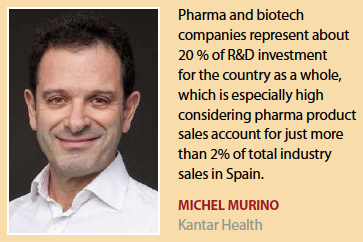 United Kingdom and Germany overall," he says. “Currently, there are 473 drug development programs ongoing in Spain."
United Kingdom and Germany overall," he says. “Currently, there are 473 drug development programs ongoing in Spain."
In terms of therapeutic areas, Spain’s R&D is largely focused on oncology, central nervous system, and infectious diseases, Mr. Dion says.
In addition, Silvia Ondategui-Parra, M.D., Ph.D., partner-MED healthcare and life sciences leader and global market access and reimbursement leader at EY, says other areas of concentration are dermatology, respiratory, and pain management.
Pricing policies and promotion of generics have created challenges for pharmaceutical companies marketing their products in Spain. According to GlobalData, pricing policies introduced in 2011 and 2012 forced companies to keep their products pricing lower than the reference price, and at the same time pharmacists are required to dispense the cheapest drug available.
“About half of all prescriptions in Spain are generic, which is less extreme than the other EU markets, where generic prescribing is either dominant such as in the United Kingdom and Germany, or low in Italy and France," Mr. Dion says.
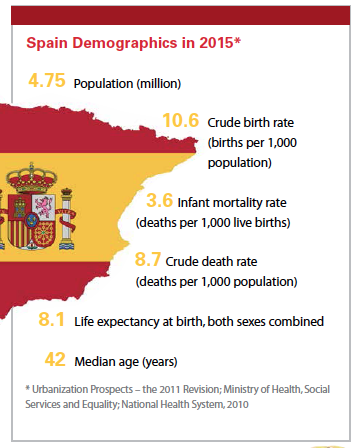 As a result of pricing policies, in 2011 investment in R&D within the Spanish pharmaceutical industry fell below the 1 billion euro mark for the first time since 2007, to EUR974 million, Dr. Ondategui-Parra says.
As a result of pricing policies, in 2011 investment in R&D within the Spanish pharmaceutical industry fell below the 1 billion euro mark for the first time since 2007, to EUR974 million, Dr. Ondategui-Parra says.
“It’s not only the private sector that has slashed its investment in pharmaceutical R&D," she notes. “The Spanish government cut funding for R&D by one-fourth in 2012, which brings funding back to 2005 levels, once inflation is taken into account. Health-related public R&D accounted for 0.15% of GDP in Spain in 2010, placing the country behind the United States, Sweden, Denmark, Netherlands, Norway, Austria, Finland, France, and Germany."
Furthermore, in March 2015 the Spanish Ministry of Health announced plans to reduce the price of biosimilars by up to 30%.
However, as compared with other industries in Spain, pharma and biotech invest the highest percentage of sales into R&D, with the sector investing 15% of sales in research, says Michel Murino, CEO, Southern Europe, Kantar Health.
“Pharma and biotech represent just more than 20% of R&D investment for the country as a whole, which is especially high considering pharma product sales account for 2.4% of total industry sales in Spain," he says. “Total R&D investment in 2012 was 996 million euros, up 1.6% from 2011."
Dr. Ondategui-Parra says the degree of differentiation in terms of drug reimbursement schemes also varies across the different regions, with Catalonia and Madrid offering the most innovative options.
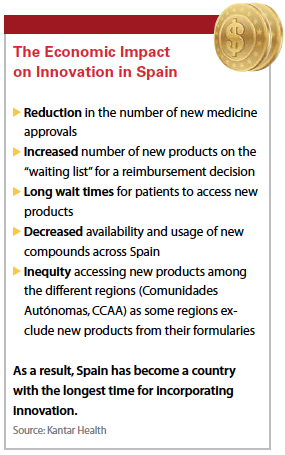 She notes, however, that a difficult economic environment has created many barriers for market access to innovative drugs in Spain.
She notes, however, that a difficult economic environment has created many barriers for market access to innovative drugs in Spain.
“For example in the rare disease segment, Spain lacks 40% of the drugs approved for marketing in Europe, due to delays in its reimbursement policies," she says. “In a 2013 study performed by the European Union of the investment in innovative treatments, Spain sits in 17th place on a list of 27 countries. And in the three years prior to the study, only seven of 27 innovative oncology medicines approved in the EU were marketed in Spain."
A Clinical Setting
The clinicaltrials.gov website lists 2,361 trials that started in Spain between 2011 and 2014, 77% of them sponsored by the pharmaceutical industry, while public-sponsored studies decreased 50% during this four-year period.
Data for trials performed in Spain — both local and international IND or other — shows that Spain takes part in 18% of the trials performed in Europe. Laura Sánchez, Ph.D., senior director, clinical site monitoring head of Spain and Portugal, Quintiles, notes that a total of 141 different pharmaceutical companies were identified as sponsors for the single country Phase I-IV trials registered as starting in Spain in 2013. The most active are the biggest international companies. In the same year, more than 700 clinical trials were approved in Spain, while the total number of studies approved in the European Union was 3,750. Overall, the number of clinical trials decreased about 15% in Europe in the period 2007 to 2011, but increased about 12% in Spain.
Clinical trials in Spain are regulated by the Royal Decree, which was adopted in 2013, Dr. Ondategui-Parra says.
In addition, a Spanish Clinical Trials Register compiles all clinical trials performed with human medicines, with the purpose of 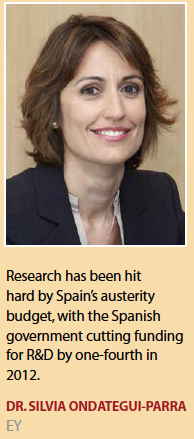 promoting transparency of clinical drug studies and easing the availability of information, she explains.
promoting transparency of clinical drug studies and easing the availability of information, she explains.
Since Spain is within the EU, its regulations fall within those established by the European Medicines Agency. According to EU regulations any clinical trial that includes an investigation center located in an EU member state needs to be included in the EU clinical trials database, known as EudraCT. Having the EudraCT number, applicants can apply for a New Clinical Trial authorization through the ECM portal of the Spanish Agency for Drugs and Healthcare Products, Dr. Ondategui-Parra says.
Since Spain is within the EU, its regulations fall within those established by the European Medicines Agency. According to EU regulations any clinical trial that includes an investigation center located in an EU member state needs to be included in the EU clinical trials database, known as EudraCT. Having the EudraCT number, applicants can apply for a New Clinical Trial authorization through the ECM portal of the Spanish Agency for Drugs and Healthcare Products, Dr. Ondategui-Parra says.
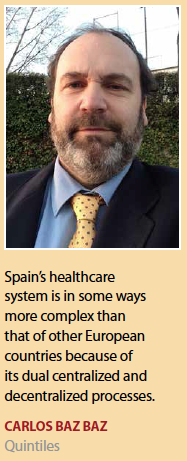 Mr. Dion says that with its highly developed healthcare infrastructure, Spain is an ideal environment for clinical trials.
Mr. Dion says that with its highly developed healthcare infrastructure, Spain is an ideal environment for clinical trials.
“There are currently about 2,490 clinical trials either ongoing or planned in the country, an almost identical number to that in Italy, but fewer than in France, Germany, and the United Kingdom," he says.
Mr. Murino says since 2009, observational research studies need to adhere to the Post-Authorization Safety Studies (PASS) regulation, which requires that every research protocol be submitted to the Competent Authorities for previous classification as prospective, linked-to-authorization, other designs, or non-PASS.
According to the classification provided, the study will then be submitted to at least one ethics committee for evaluation to obtain the corresponding approval. To avoid the prospective research linked to prescription induction, the observational studies require regional approvals from the competent autonomous communities as a mandatory step to start and conduct the research regionally.
He adds that regulation of non-interventional studies in Spain has improved, particularly with regard to ethical and methodological issues, and today studies are focused on improving patient protection and avoiding studies that are focused on promotional goals.
Dr. Sánchez notes that study start-up times are considered slow, but improvements in the Spanish regulatory environment have led to an increase of 4% in the number of clinical trials approved in Spain.
“The new draft of the Spanish Law for Clinical Trials issued in April 2014, which is expected to be implemented by May 2016, reduces the number of steps, as well as costs, required for the approval of clinical trials, simplifies procedures, and reduces bureaucracy, without jeopardizing patients’ safety and security," Dr. Sánchez says.
This law also includes some potential improvements at the local level, with a reduction in approval timelines and process harmonization being key.
“The new law should improve the chances of quick access to new treatments to patients, although there is still a question mark with regard to whether this law will be able to reduce contract negotiation burdens and timelines," Dr. Sánchez says.
Evaluation timelines have been agreed upon: submissions will be validated in 10 days, evaluated in 45, and approved or rejected in five. This will reduce the time between submission and first-patient in from 120 days to about 75 days. Meeting these challenging timelines will depend on the coordination of the Spanish government with the 17 regional regulatory bodies that currently have evaluation and approval competencies. Overcoming this challenge will allow Spain to be competitive and bring new and innovative treatments to market.
Transparency is also one of the focuses of this new law. Clinical trial information will become public, and authorizations will expire in two years if there has been no patient included in the study.
Dr. Sánchez notes that there has been a significant increase in the number of oncology studies in all phases taking place in Spain, and there is ongoing research in the neurology field, while areas such as cardiology and psychiatry have experienced a decrease in the number of clinical trials starting in Spain.
Managing Marketing Regulations
Spain’s regulatory environment, based on EU directives, is more transparent than some of its European peers, notably in Eastern Europe, and less transparent than in Western countries, according to Dr. Ondategui-Parr.
“In Spain as in any of the other EU countries, marketing authorization (MA) can be obtained both via the Centralised Procedure and the National Spanish Procedure," she says.
Through the Centralised Procedure companies gain validation for a product across all EU member states simultaneously, and this process can take up to 210 days. The National Spanish procedure leads to an MA valid only in Spain and processing times for it are estimated to range between six and nine months, Dr. Ondategui-Parr comments.
Once a product is licensed for marketing, the local pricing and reimbursement process begins. This starts with the preparation of a Therapeutic Positioning Report — a new system that is being gradually introduced. The report will inform the pricing decisions made by the Interministerial Medicine Pricing Committee.
“This process is not standard, and from the moment a product is approved for marketing until the moment a P&R resolution is reached can take on average between eight and 12 months," she says.
Mr. Murino says one year post-launch prices are revised and depending on whether the product has new indications or if sales are above initial estimates, prices can be lower than at launch.
“Price setting usually is based on criteria such as level of innovation, economic evaluation, and pricing in other EU countries," he says. “The Ministry of Health issues the key recommendations for new product usage and provides a report that explains what the main therapeutic position is in the clinical management of the disease.
Mr. Murino adds that the regions have an assigned budget for healthcare, and pharma expenditure is part of it. Based on their healthcare budget, the regions perform their economic evaluation and decide whether to incorporate the product into the regional formulary. Based on the central recommendations, regions revise and set the criteria for eligible patients of a specific compound.
“Hospitals are another decision-making body for market access, as they need to decide whether to incorporate a new product into formularies based on budget, cost-effectiveness data, and demand from clinicians," he says. “The incorporation of a specific innovation into the hospital guide can take from three months to 24 months in some cases."
Healthcare Access
The Spanish National Health System (Sistema Nacional de Salud) is not a single organization and is made up of both central and Autonomous Community (AC) health departments that are managed and co-ordinated with one another through the Inter Territorial Board (ITB), GlobalData notes. The ITB is the supreme health authority in Spain and is directly managed by the Ministry of Health, Social Services and Equality.
Healthcare is provided free of charge to all social security affiliates, pensioners, and immigrants residing in Spain having a certain income level, Dr. Ondategui-Parra says. Foreigners not residing in Spain can receive public-funded treatment only in case of emergencies or pregnancy.
Nevertheless, Carlos Baz Baz, head of Quintiles Commercial Services Spain, notes that private health insurance companies have seen significant growth in the past 10 to 15 years. This has helped to bolster the system.
As with other developed Western European markets, reimbursement is tiered, Dr. Ondategui-Parra says. Not all prescription drugs are reimbursed. Hospital drugs are 100% reimbursable, as are medicines for some illnesses, such as life-threatening conditions, including AIDS and cancer. Treatments for other chronic diseases are reimbursed at 90%, while other pharmacy-prescribed products for all patients are reimbursed at 60%. There is a different level of copayment for drugs depending on the income level and the social status; pensioners with non-contributory pension are exempt, the unemployed pay a copayment of 40%, while public sector employees pay a lower copayment of 30%.
However, economic constraints in Spain and recent healthcare reforms have led to a reduction in the number of reimbursed products and services.
According to GlobalData, Spain’s healthcare infrastructure is strong. This includes a commitment to the latest technology advances, including electronic health services, which have helped to improve access to healthcare for patients; a strong network of healthcare facilities; and a high proportion of healthcare professionals to patients.
Another distinguishing feature of the Spanish market is the regulation of sales representatives. According to Mr. Baz Baz, the market is not really regulated and reps can generally visit reps without an appointment. It is not uncommon, for example, for primary care visits to take place in the corridor, and the average visit is two to three minutes. Typically, a doctor will have four to five visits per week. (PV)
For bonus content go to bit.ly/PV0515-Spain



















